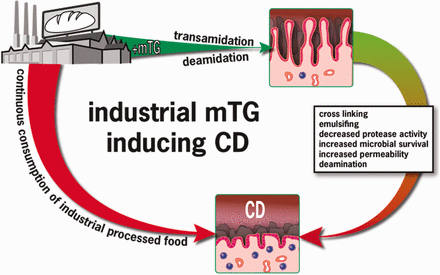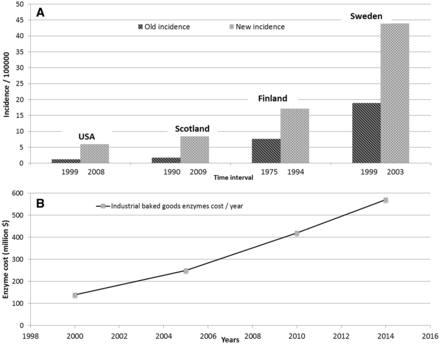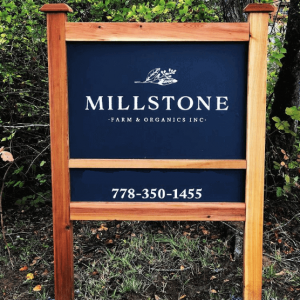Association Celiac Disease and Enzyme Used in Food Processing
, DOI: https://dx.doi.org/10.1093/nutrit/nuv011 First published online: 17 June 2015
 The food industry’s increased use of microbial transglutaminase in wheat processing and an increased incidence of celiac disease has lead to the hypothesis that microbial transglutaminase is a new environmental enhancer of celiac disease, further increasing the risk for gluten-sensitive populations.
The food industry’s increased use of microbial transglutaminase in wheat processing and an increased incidence of celiac disease has lead to the hypothesis that microbial transglutaminase is a new environmental enhancer of celiac disease, further increasing the risk for gluten-sensitive populations.
Importance of environmental factors in the pathogenesis of celiac disease
Recent studies have expanded the list of environmental triggers of celiac disease beyond that of gluten. The genetic determinants of celiac disease alone cannot explain the expression of the disease in an individual nor the recent surge in celiac disease incidence.2 It has been shown that the classical intestinal clinical symptoms of malnutrition, chronic diarrhea, and nutritional deficiencies are diminishing while extraintestinal presentations are emerging. Skin, endocrine, skeletal, hepatic, hematological, gynecological, fertility, dental, and behavioral abnormalities are often described. Today, there is an epidemiological shift in the disease phenotype toward a more advanced age of patients, with an increased prevalence of latent, hyposymptomatic, or asymptomatic presentations reported.3,4 It is logical that widespread increases in the incidence of celiac disease are triggered by environmental exposures, because genetic changes are too slow to drive such developments. While prolamines are known to play a major role in the induction of celiac disease, multiple environmental factors have been reported as enhancers of the condition. Infections like rotavirus in infants and Campylobacter jejuni in adults are associated with an increased risk of celiac disease.5
Most recently, seroreactivity to different microbial antigens was observed in patients with early-stage celiac disease, indicating that microbial targets might have a role in early development of the disease.6 The infectome–autoimmune disease relationship is congruent with the hygiene hypothesis, which states that decreased exposure to microbes may be driving the increase in autoimmune diseases. Additional environmental factors that have been associated with increased risk of celiac disease include the following: reduced duration of breast feeding, the timing and increased amount of gluten ingestion, prescription of antibiotics and proton pump inhibitors, elective cesarean section, socioeconomic factors, and, most recently, maternal iron supplementation to pregnant woman.7
Currently, research is also focused on environmental factors, gene–environment interactions, and epigenetics, especially early in life, which may help explain the onset of the disease and its increased incidence. Given the uncertainty regarding causality, these associations between celiac disease and environment mandate further investigations to elucidate the potential mechanisms by which modern exposures contribute to the pathogenesis of this condition.
Increasing incidence of celiac disease
Currently, there is a diffuse, ongoing epidemic of celiac disease.7 The prevalence of the disease is continually increasing and has increased more than fourfold in the past 50 years.8 Studies from the United States and Finland have shown a marked increase in the seroprevalence of celiac disease in recent decades. The reported incidence of celiac disease in the Western world is generally around 1%; however, incidences of 2% and 5.6% have been reported in northern European countries and in the Sahara Desert region of North Africa, respectively. Even in East and South Asia, where rice is the main staple food, an increased incidence of celiac disease has been reported, for example, in India.9
The use of isolated transglutaminase enzymes from microbiological sources in industrial food processing has allowed certain processes to be simplified, resulting in energy and cost savings. Thanks to established transgenesis procedures, gene transfer has become possible, and the expression of genes has given rise to the massive production of microbial transglutaminase. Microbial transglutaminase is used in the food industry for multiple purposes: to improve the texture, appearance, hardness, and shelf life of meat; to increase the hardness of fish products; to improve the quality and texture of milk and dairy products; to reduce the calorie content and improve the texture and elasticity of candy; to improve the stability and appearance of protein films; and to improve the texture and volume of foods in commercially baked goods.10,12 The use of microbial transglutaminase as a biological glue and as a biocatalyst in the biomedical and biotechnology fields also continues to grow. This probably represents one of the fastest-growing areas of microbial transglutaminase usage, as reflected by an increasing number of patent applications filed on the application of microbial transglutaminase in medicine.13
As a result of the increasing use of microbial transglutaminase in the food industry, the common Western diet now contains large amounts of microbial transglutaminase,10,11 with the maximum daily intake ranging up to 15 mg. Each kilogram of food treated with microbial transglutaminase contains about 50–100 mg of microbial transglutaminase.14 Figure 1 shows the direct correlation between the annual increase in celiac disease incidence and the higher consumption of enzymes ingested through commercially baked goods in Western countries.7,8,15,16 This observation leads to the question of whether the increased use of microbial enzymes in industrial food processing is associated with or has caused the increased incidence of gluten intolerance in recent decades. The question is especially of interest considering gluten is a preferred substrate for both human and microbial transglutaminases.
Currently, research is also focused on environmental factors, gene–environment interactions, and epigenetics, especially early in life, which may help explain the onset of the disease and its increased incidence. Given the uncertainty regarding causality, these associations between celiac disease and environment mandate further investigations to elucidate the potential mechanisms by which modern exposures contribute to the pathogenesis of this condition.
Potential effects of microbial transglutaminase on intestinal permeability
Intestinal permeability is increased in celiac disease, allowing increased trafficking of macromolecules between the lumen and the host. The tight junction is a complex structure with a gatekeeper function and is under strict regulation. The abnormal function of the tight junction is a major step in celiac disease pathogenesis.55
Conclusion
Until further studies provide additional information, it is recommended that any use of microbial transglutaminase in the commercial processing or baking of food be disclosed on the packaging label to ensure transparency for consumers, as is currently required in Switzerland by the regulatory authorities.77 Gluten-free products are known for their potential contamination. Use of microbial transglutaminase can further increase the risk for gluten-sensitive populations.
Read the entire study at https://nutritionreviews.oxfordjournals.org/content/early/2015/06/16/nutrit.nuv011







